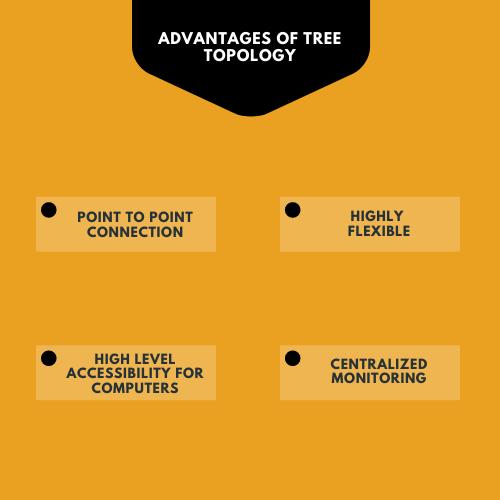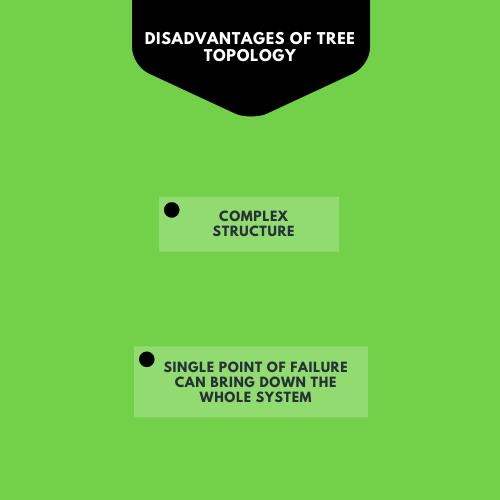Tree Topology Advantages And Disadvantages: A Detailed Comparison
Question
Task: Evaluate tree topology advantages and disadvantages.
Answer
Introduction
The overall system of nodes present in the overall network in a systematic layout is termed to be network topology. It depends on the network topology on how the data is transacted or exchanged between the different units present in the network.
Before we get into the discussion of tree topology advantages and disadvantages, let's discuss tree topology. It is the systematic organization of star topology and various bus topologies which forms the tree topology. The possession of various servers on the same network is made possible by the implementation of tree topology techniques. A particular symmetrical pattern is followed to connect a particular level to the next unit at a higher level by following a hierarchical pattern to form a tree topology. The instance when the network is immense, the tree topology turns out to be the best technology to follow. Though the same technology is considered to be inefficient and a waste of cables if the network is very small (Xie & Wang, 2014).

Below are mentioned some of the additional features of the tree topology. Let us have a detailed look over it.
- The tree topology is composed of a combination of two different topologies. They are bus topology and star topology respectively.
- The hierarchical disintegration of the tree topology is generally classified into three different levels of hierarchy. All the work is carried out at the root network, and the processed data is further transferred to these three levels of hierarchy.
While selecting the topology for a system, there are certain parameters that should be considered. They are: -
- The specifications of the cables to be used in the network system.
- Expenditure, the executor should calculate whether the cost of the planned topology is within the estimated budget or not.
- The required length of the cable to execute the topology.
Background
To check the background of the tree topology, it is very crucial to analyze the tree topology advantages and disadvantages.

The constructive aspect of the tree topology
Point to point connection
Every unit or computer should be connected to the major hub when making a tree topology. It should be ensured that every section of the network is connected to the main wire or cable (Singh, 1985).
Highly Flexible
The units or the additional computers should be easily added to the topology network by using a hub.
The higher level of accessibility for the included computers
The included computers in the topology should have a higher level of accessibility to the network. It will be considered an inefficiency of the topology if any computer has less accessibility to the network (Zied, 2008).
Centralized monitoring
The parameter of centralized monitoring enables users to supervise and make adjustments to the larger networks. The feature also enables the user to reconfigure the components of the implied tree topology.
- By using simple cable extensions, further computers should be added to the topology. It is one of the exclusive properties of the tree topologies.
- The proper working of the tree topology requires several software vendors and sophisticated hardware.

The negative aspect of implying tree topology
Very complex to configure
It requires specific technical brilliance to design out an impeccable network based on tree topology. It requires large networks of wire to make the tree topology active. It sometimes gets very tricky to handle such long loops of wires in the network system.
A single point of failure could bring down the whole system.
The whole system of the tree topology network would go down if the main wire (which is considered to be its backbone) ceases to work. The units or the components involved in the tree topology network will fail in communicating with other units if the backbone of the network fails (Mottola, 2008).
The complexity and the length of cables used in the network would exclusively depend on the characteristics and specifications of the wire.
Application of tree topology
The tree topology could be implied in various instances. Some of them are listed down in the below section of this article on tree topology advantages and disadvantages.
- When the information is to be transferred through an immense network.
- The units connected to the topology could be easily identified, and there would be no challenges or complexity in connecting to a larger network.
- If it is intended to reduce the traffic in the network to a considerable level.
The same user or the computer can hold a multitude of servers in the same network by implying the tree topology (Park, 2009).
Conclusion
It has been observed in this report on the tree topology advantages and disadvantages that the tree topology is formed by assimilating the techniques of bus topology and star topology. The tree topology turns out to be more efficient when the larger networks are intended to be built. If considered the advantages of the tree topology, it provides the facility of point to point connection, high flexibility, and centralized monitoring to the comprised units. Though the weakness like a single point of failure and very difficult to be conjured comprises to be the major negative aspects of the tree topology. It is very convenient to identify any comprised unit in the tree topology network, and at the same time, it facilitates to retain multiple servers simultaneously. Among other networking technologies, the tree topology is considered to be the best one since the transmissions are done imminently in it. As per this tree topology advantages and disadvantages paper, the principle that makes it possible is the transmission of signals at the root level nodes, which is imminently obtained by the connected computers.
Reference
Mottola, L., Cugola, G., & Picco, G. P. (2008). A self-repairing tree topology is enabling content-based routing in mobile ad hoc networks. Tree topology advantages and disadvantages, IEEE Transactions on Mobile Computing, 7(8), 946-960.
Park, J. H., Liu, Y., Lee, M. J., Hu, X. H., & Kwon, T. K. (2009). U.S. Patent No. 7,583,592. tree topology advantages and disadvantages, Washington, DC: U.S. Patent and Trademark Office.
Singh, R. P., VanderVoort, R. J., & Likins, P. W. (1985). Dynamics of flexible bodies in tree topology-a computer-oriented approach. Tree topology advantages and disadvantages, Journal of Guidance, Control, and Dynamics, 8(5), 584-590.
Xie, S., & Wang, Y. (2014). Making of tree network with limited delivery latency in homogeneous wireless sensor networks. Tree topology advantages and disadvantages, Wireless personal communications, 78(1), 231-246.
Zied, M., Hayder, M., Emna, A., & Habib, M. (2008, May). Efficient tree topology for the FPGA interconnects network. Tree topology advantages and disadvantages, In Proceedings of the 18th ACM Great Lakes Symposium on VLSI (pp. 321-326).












